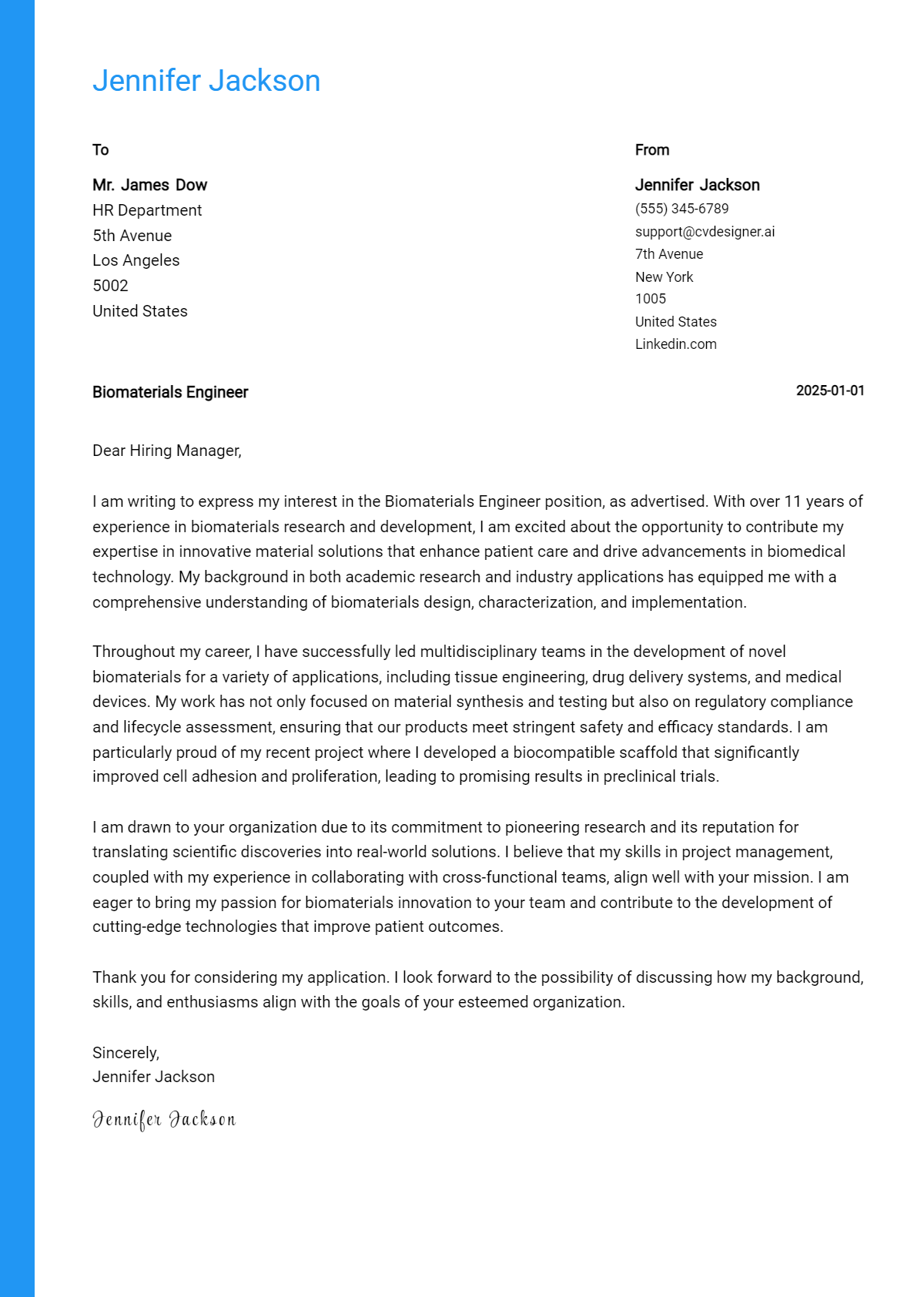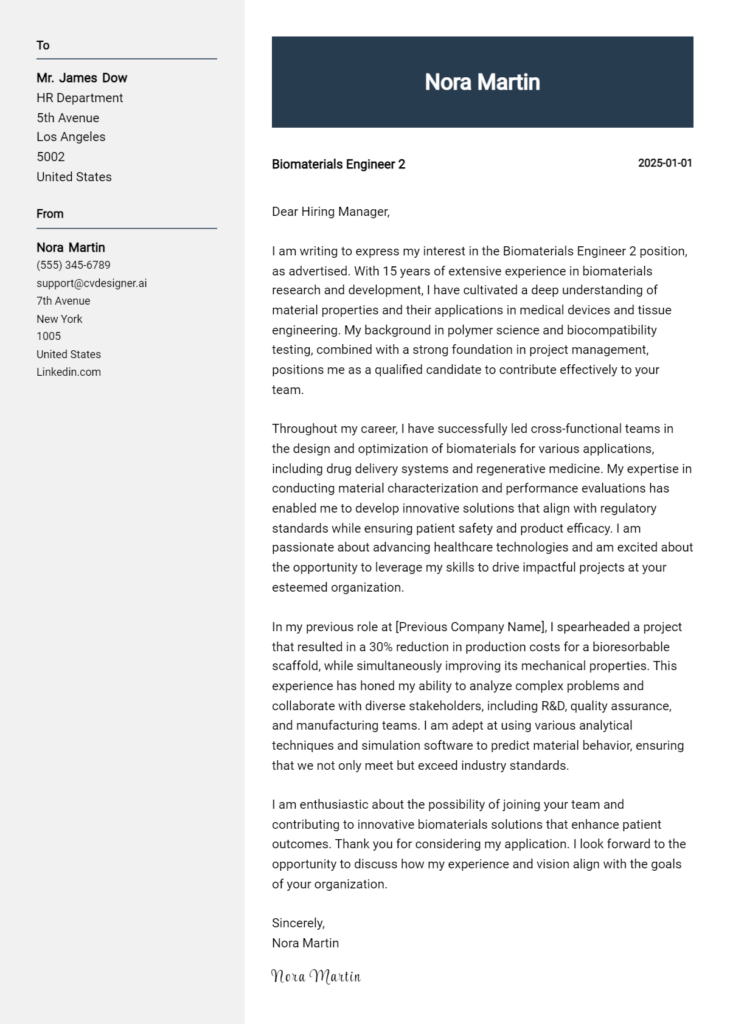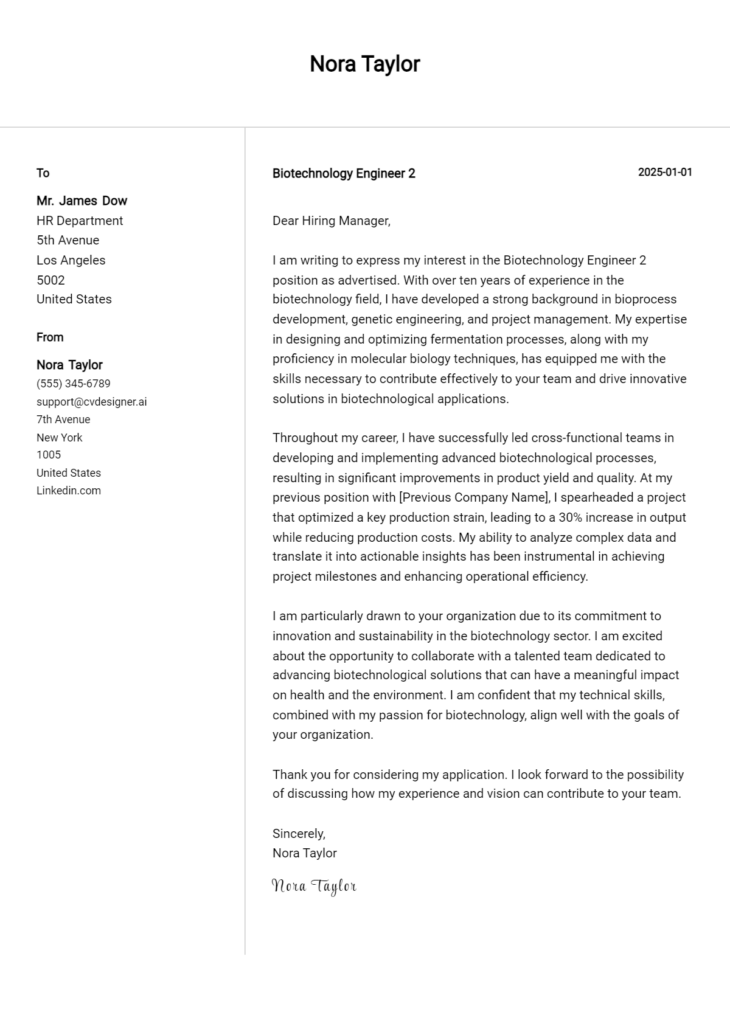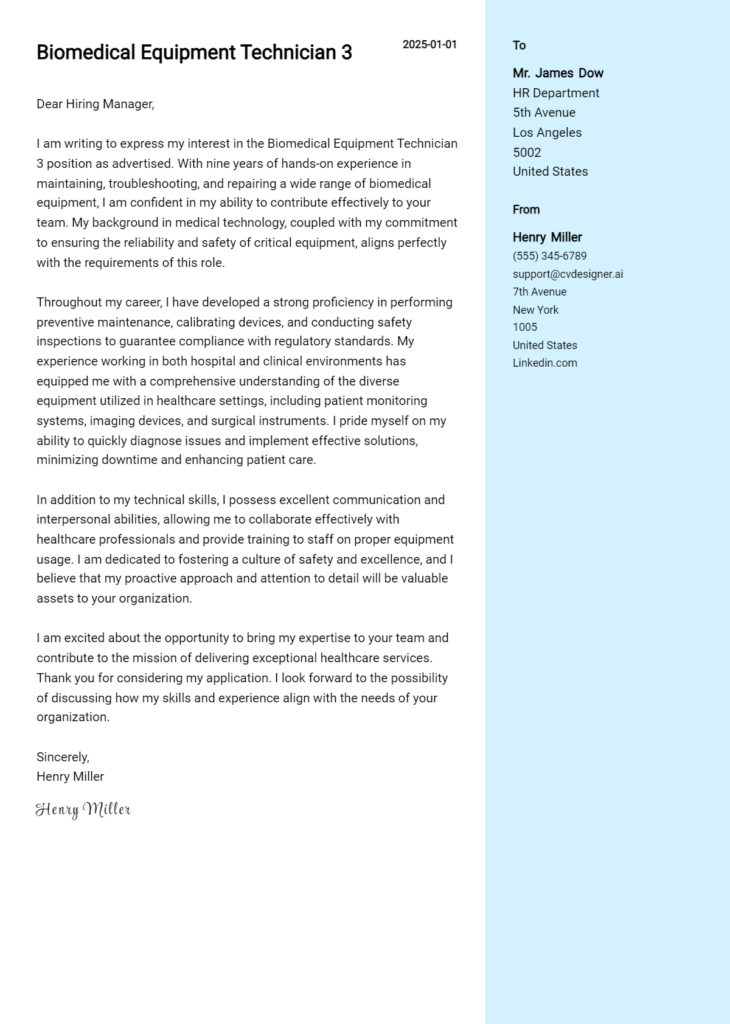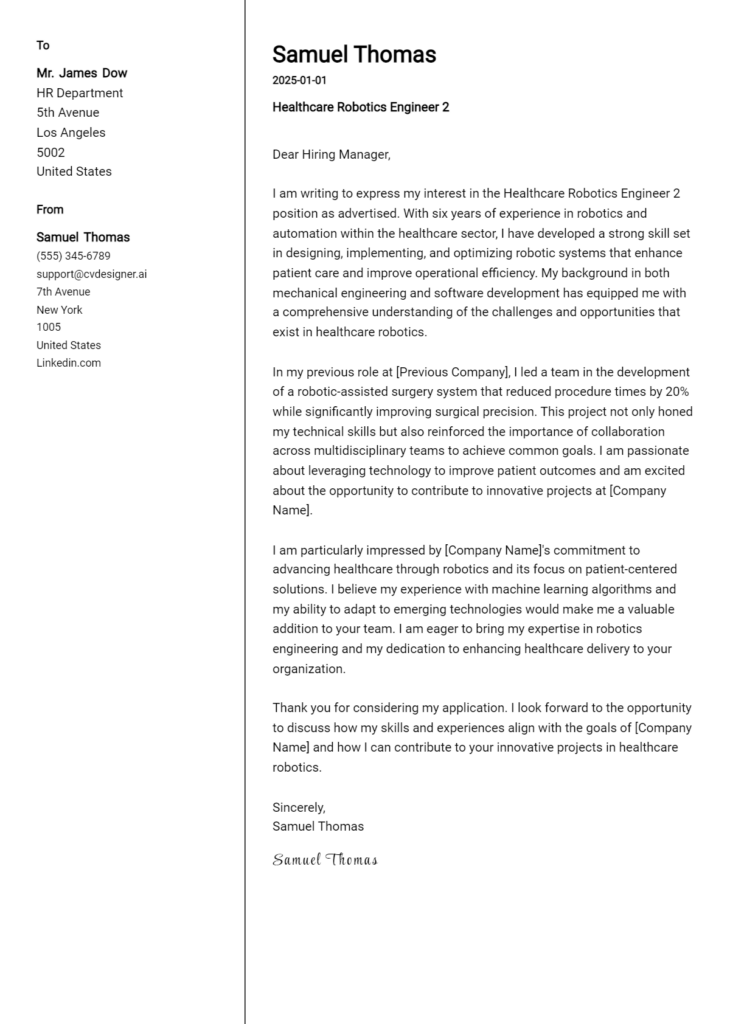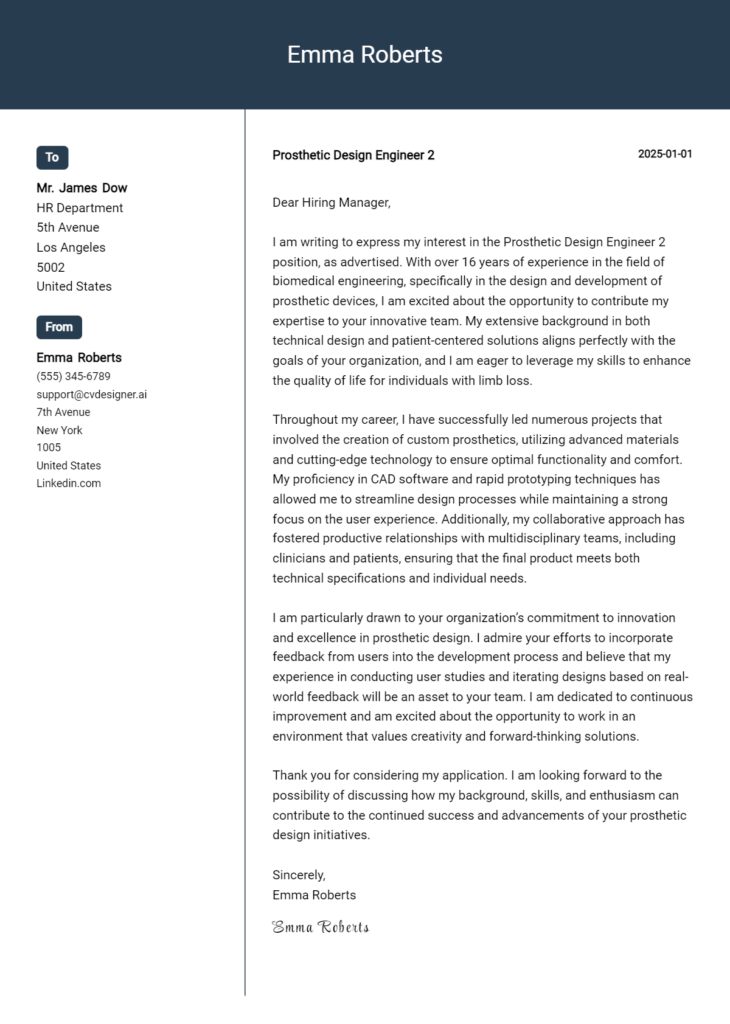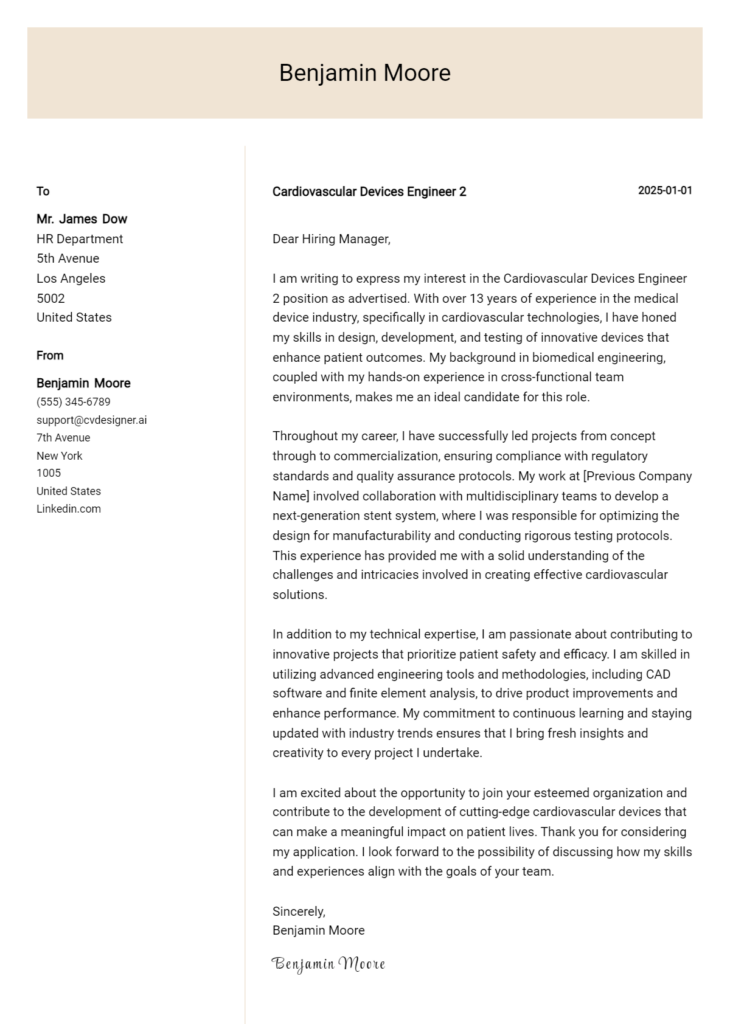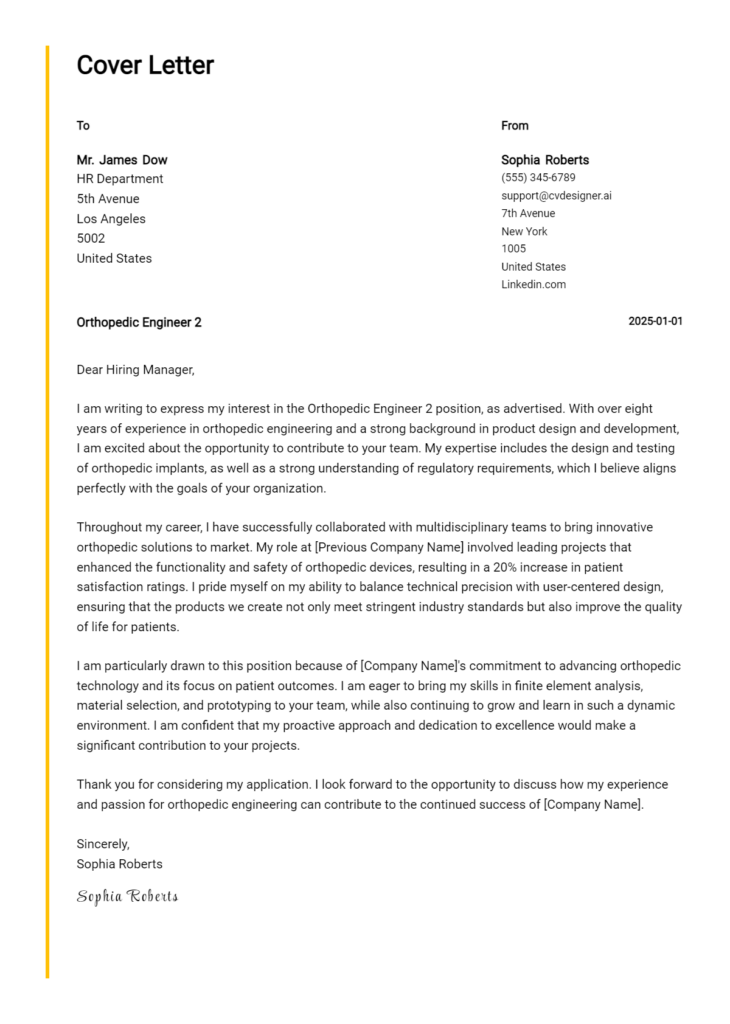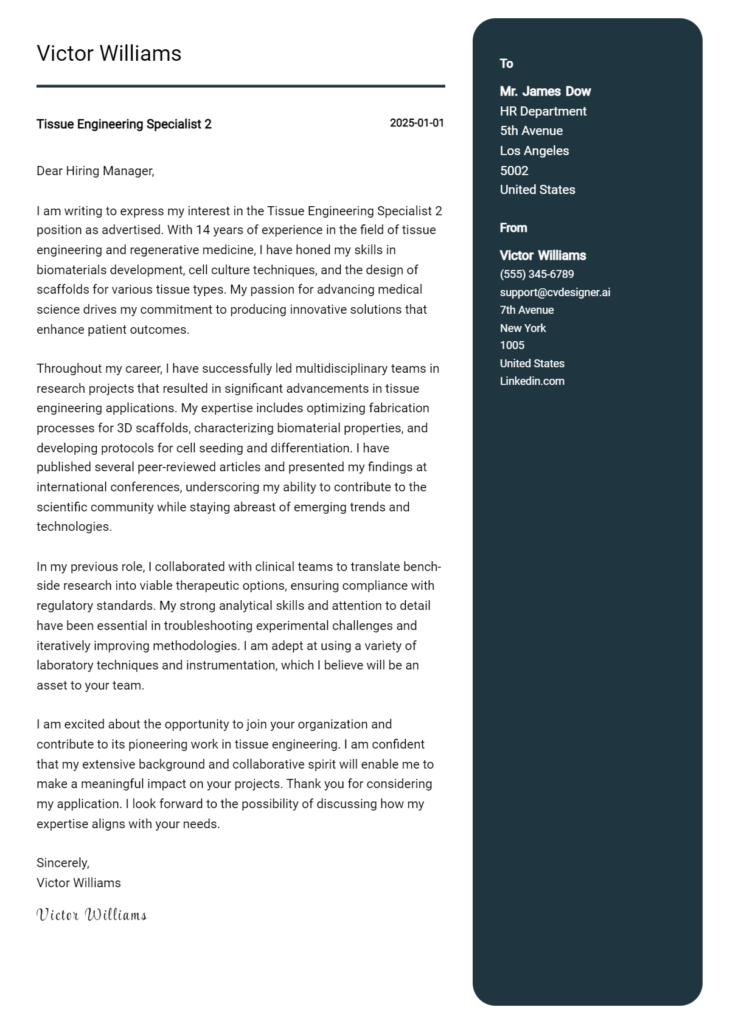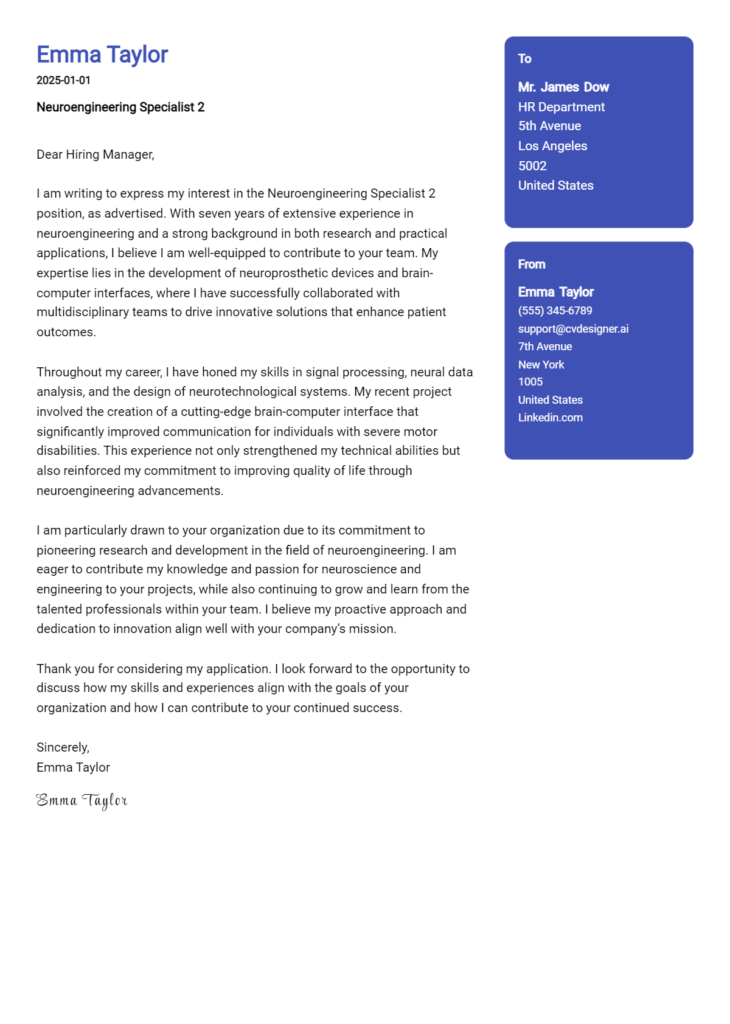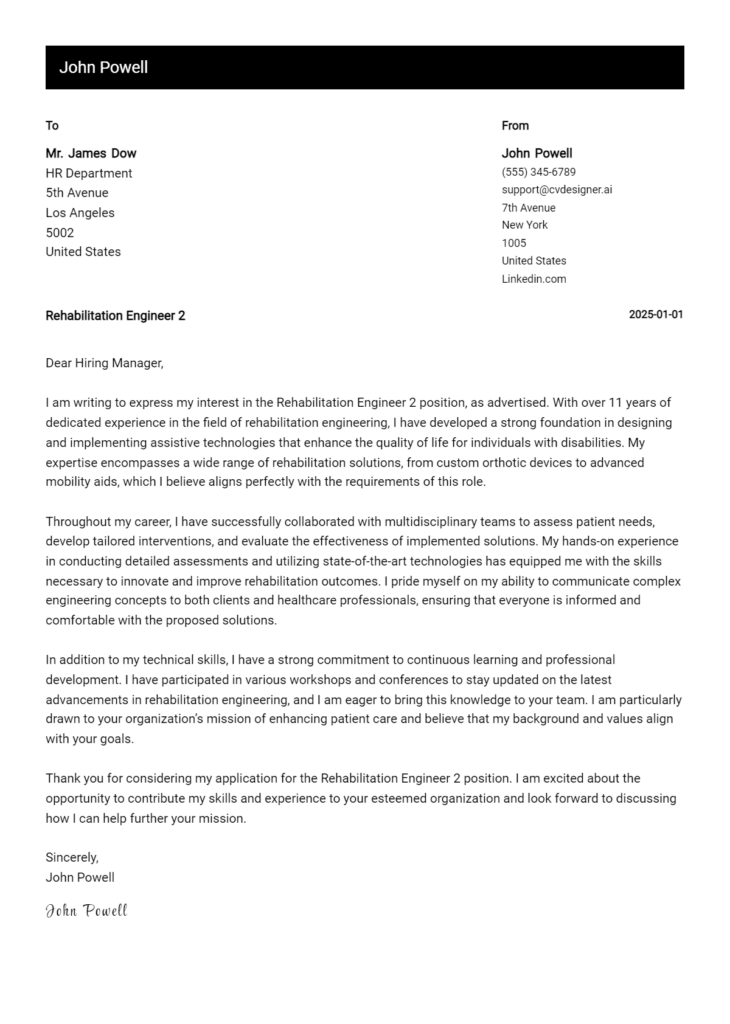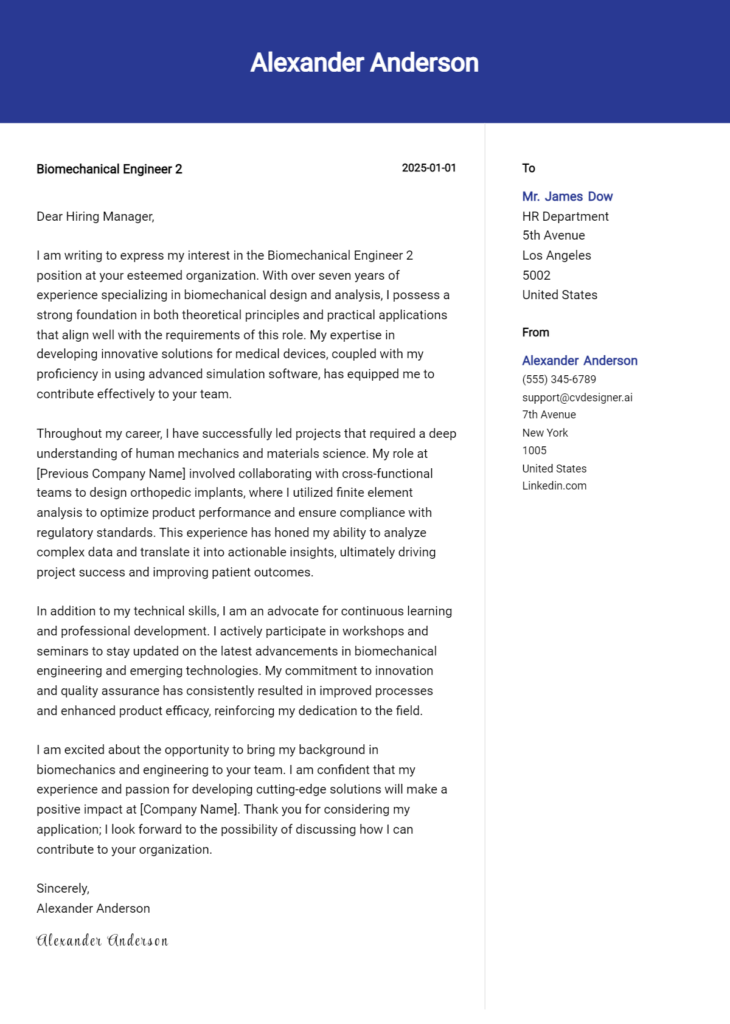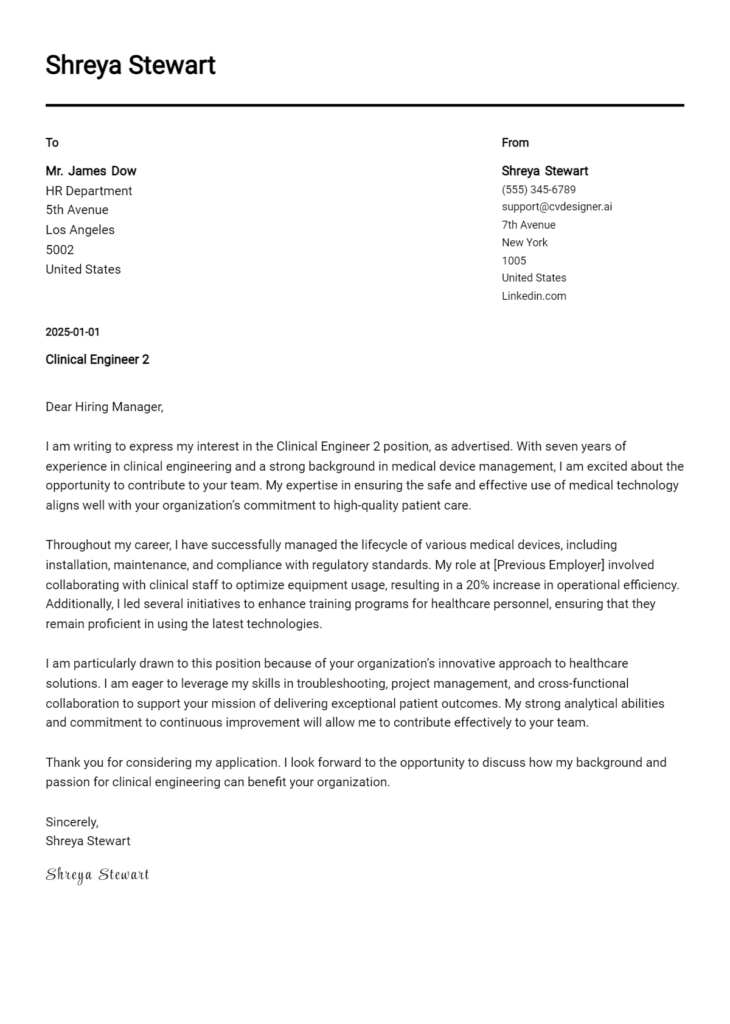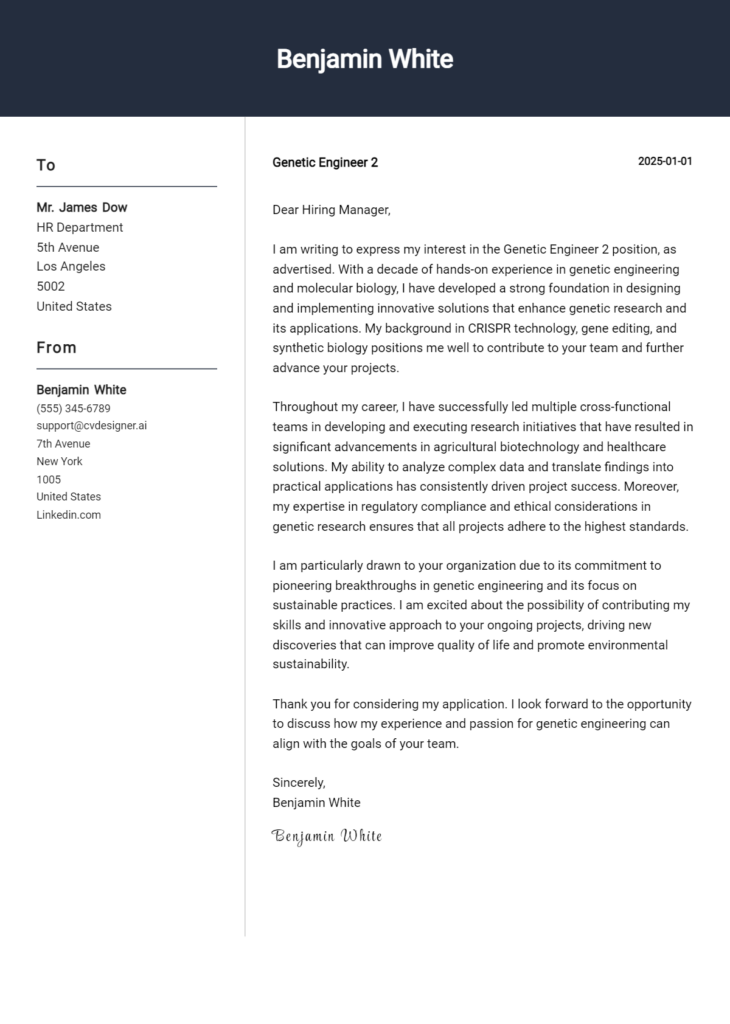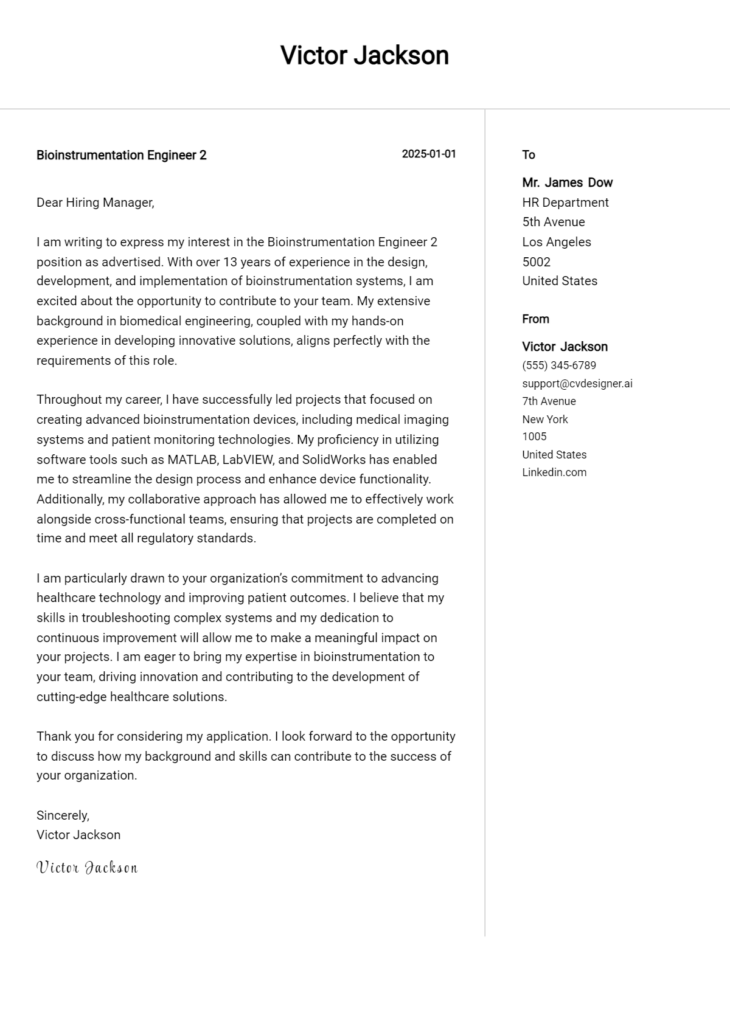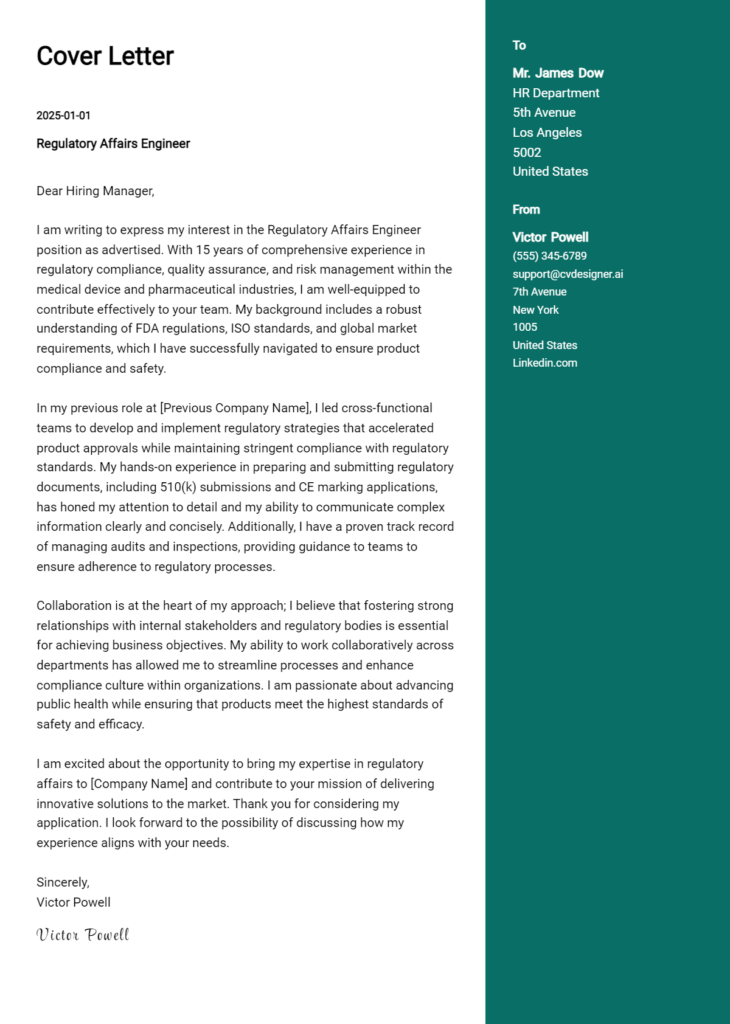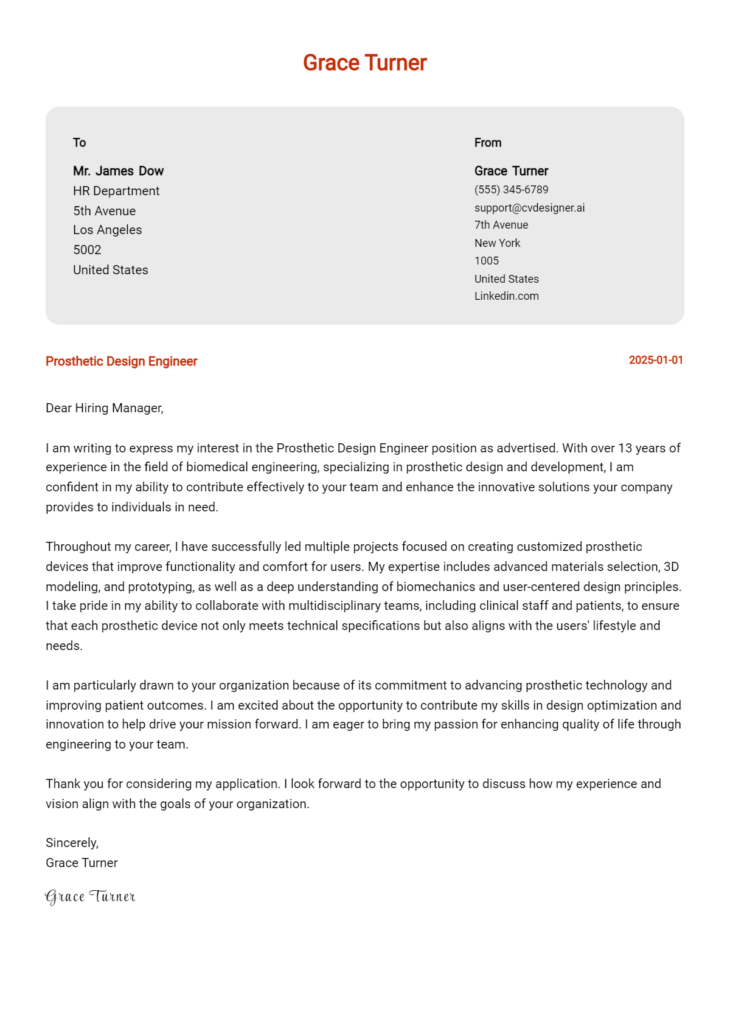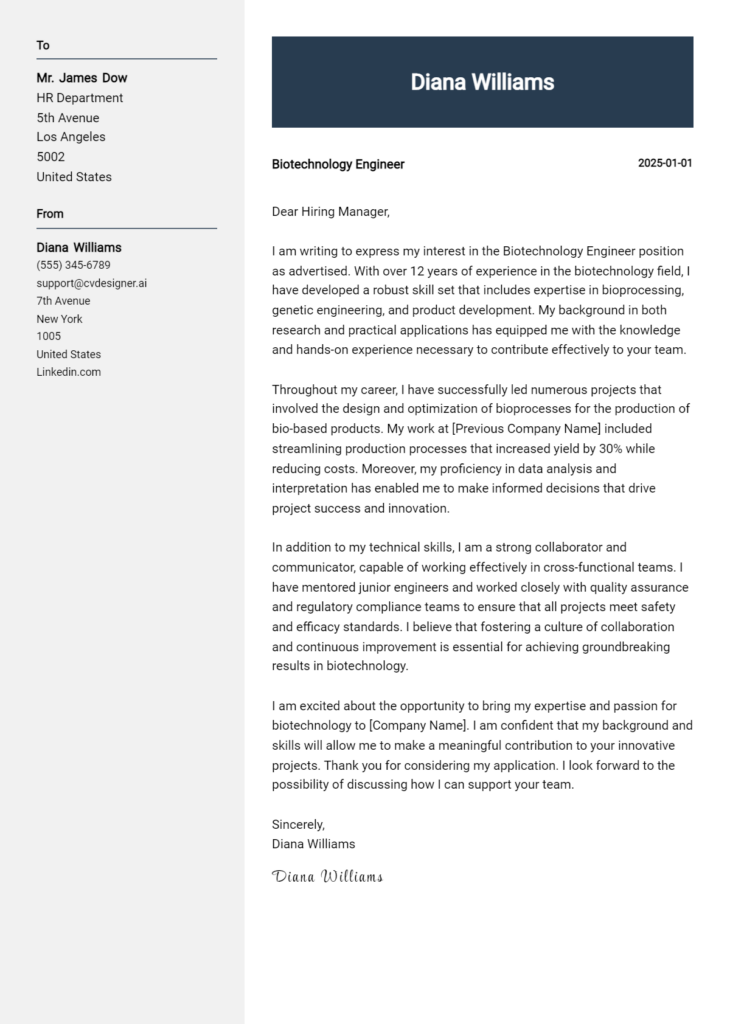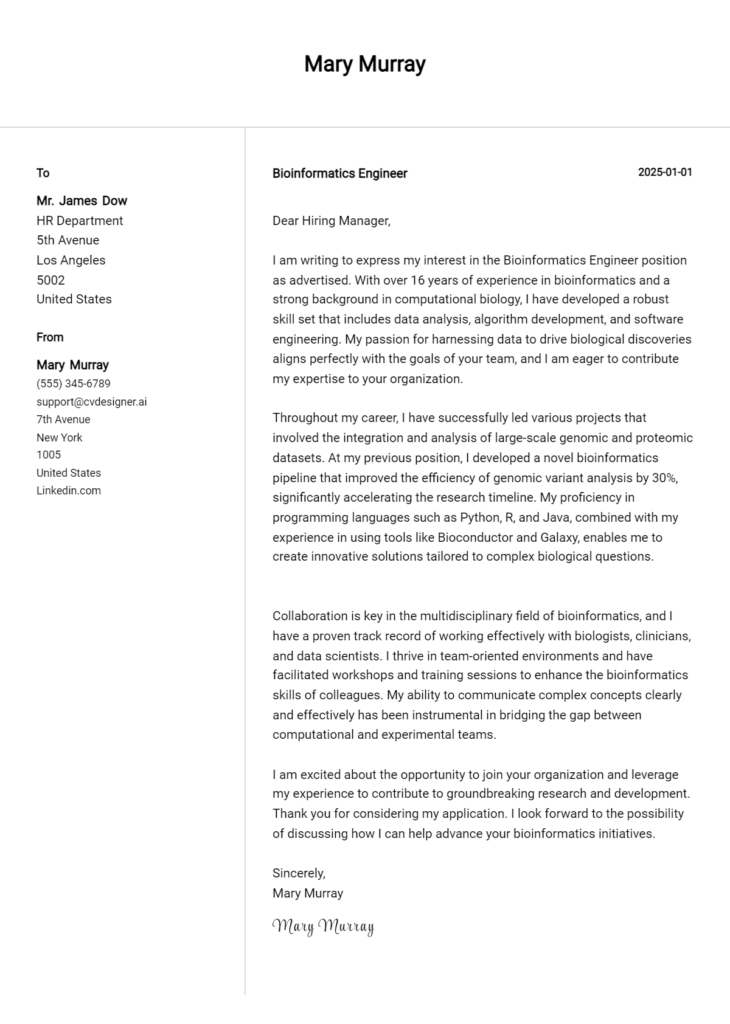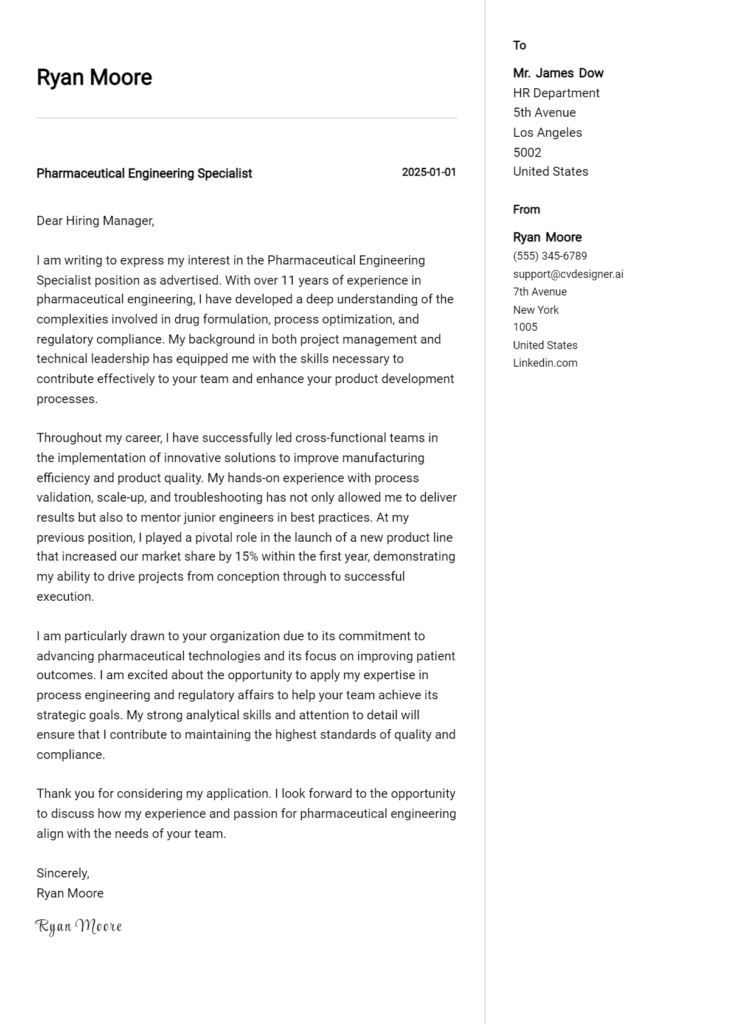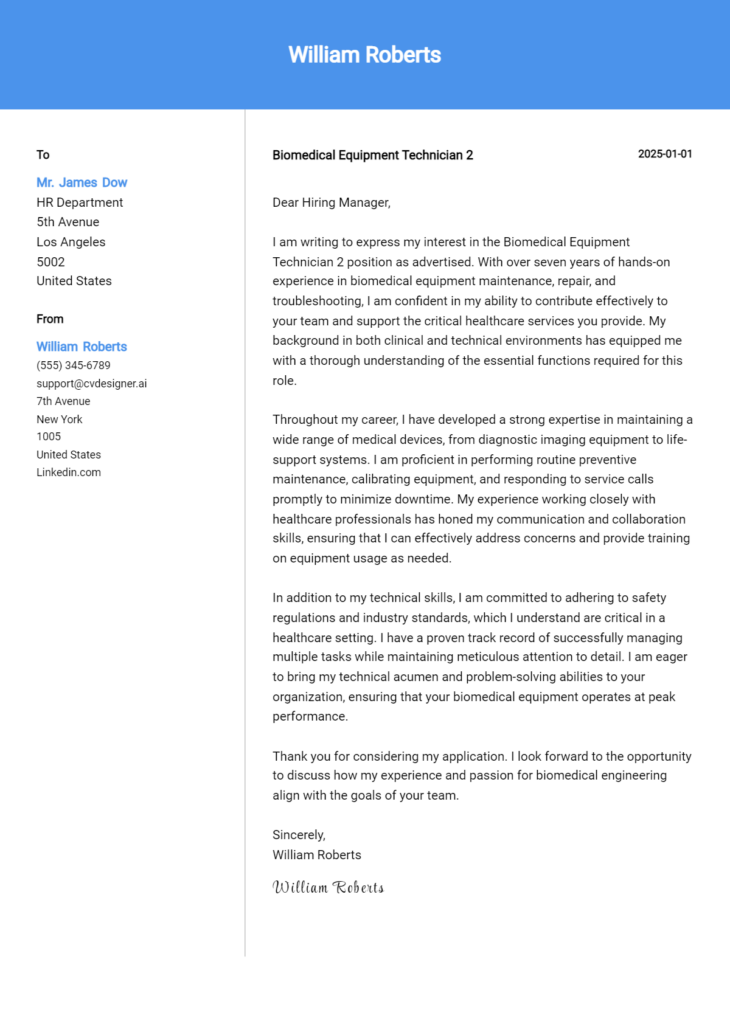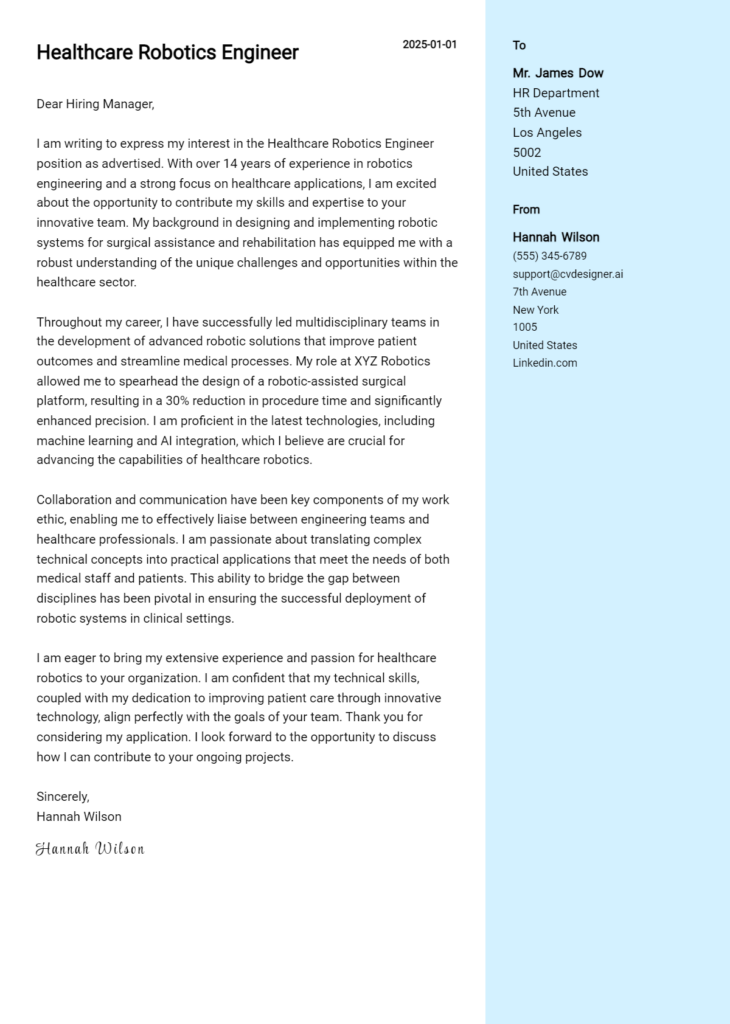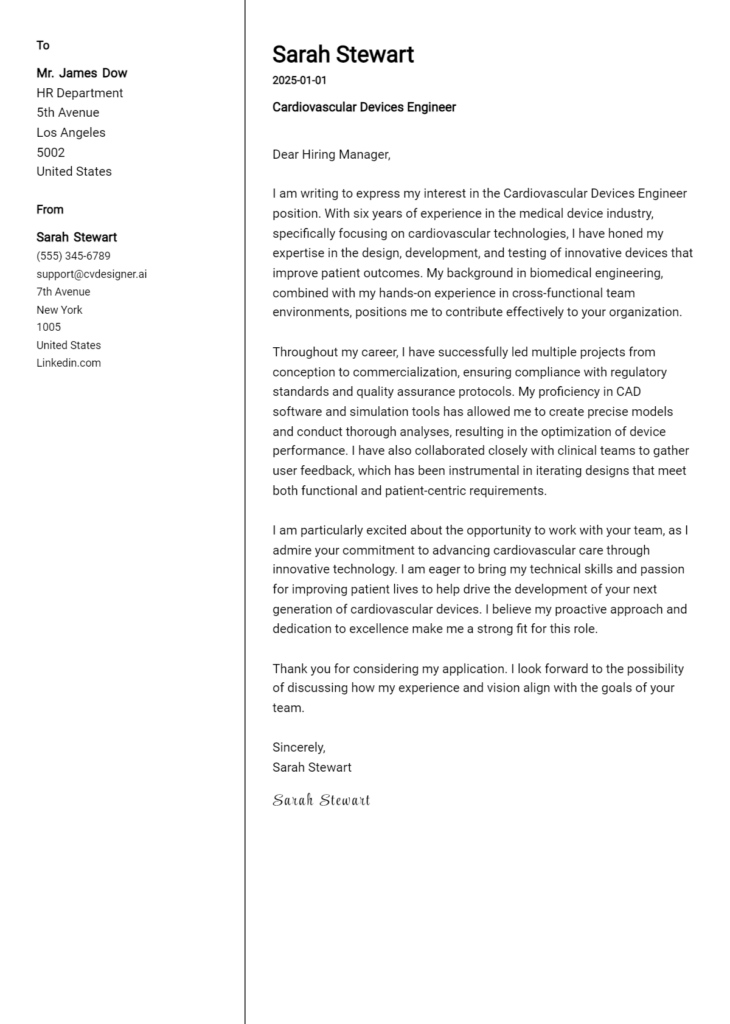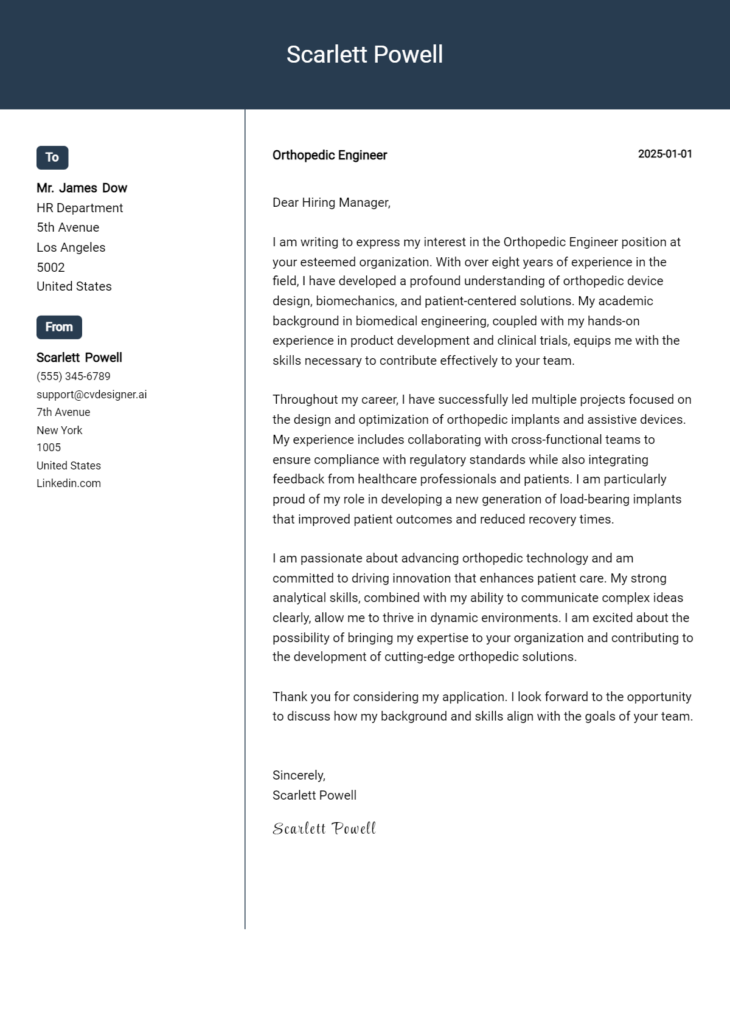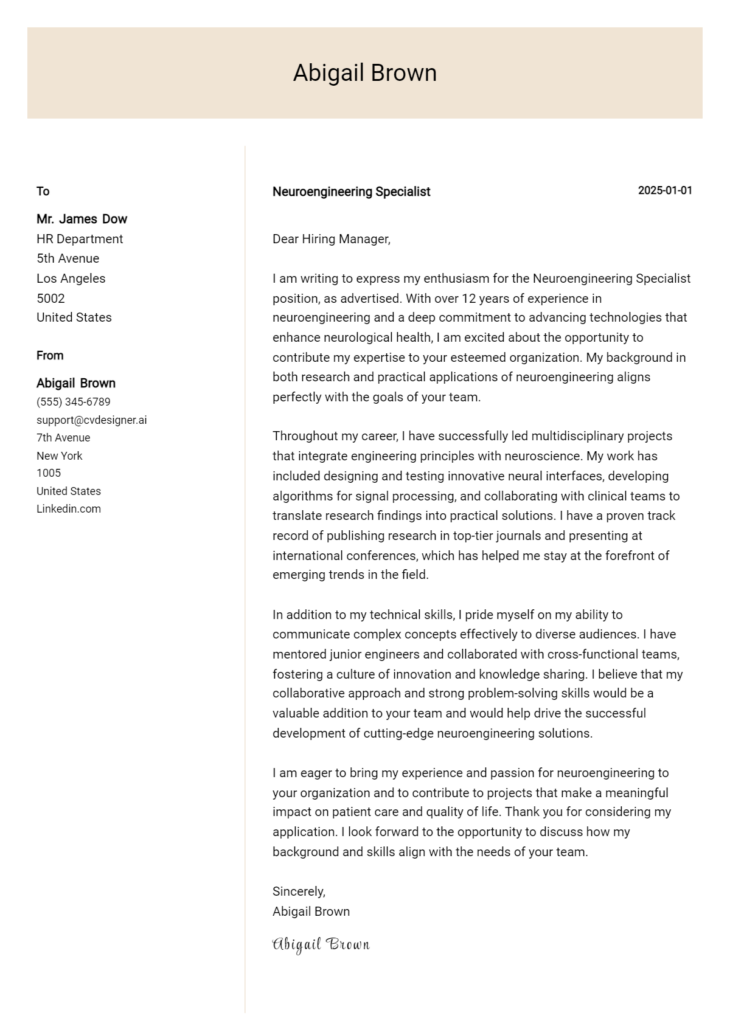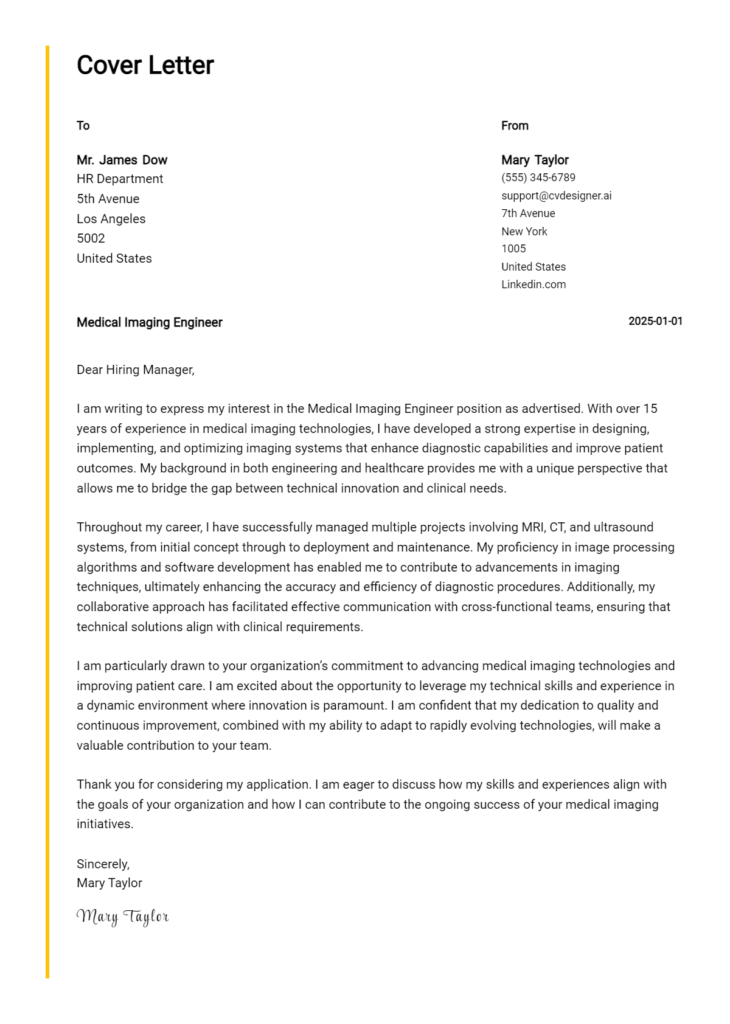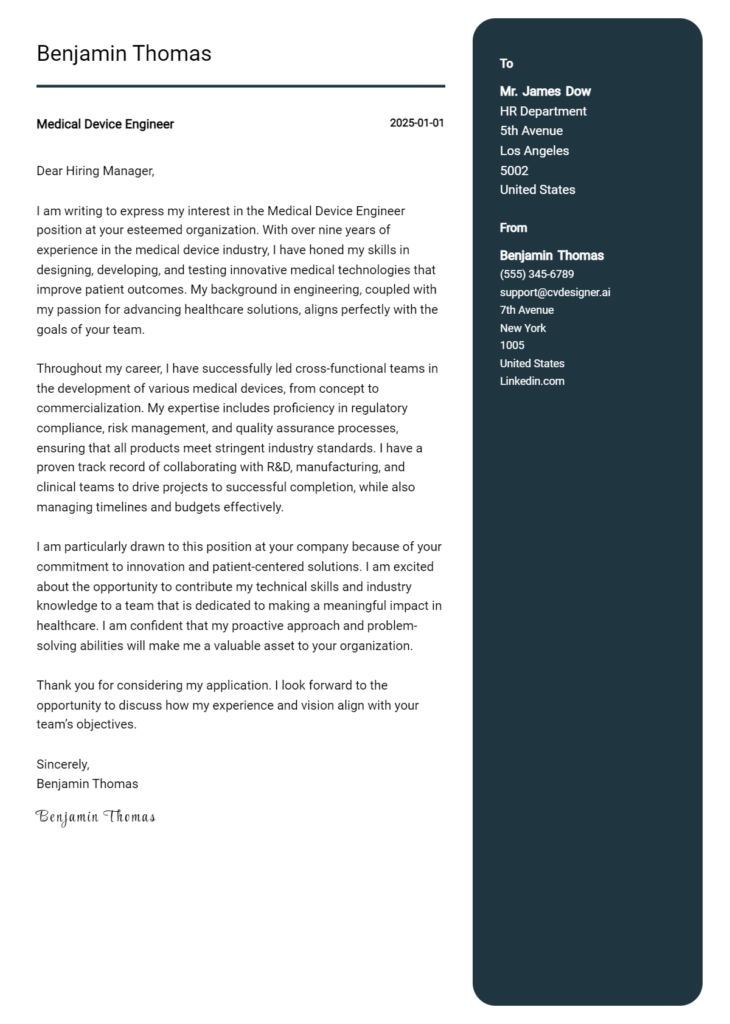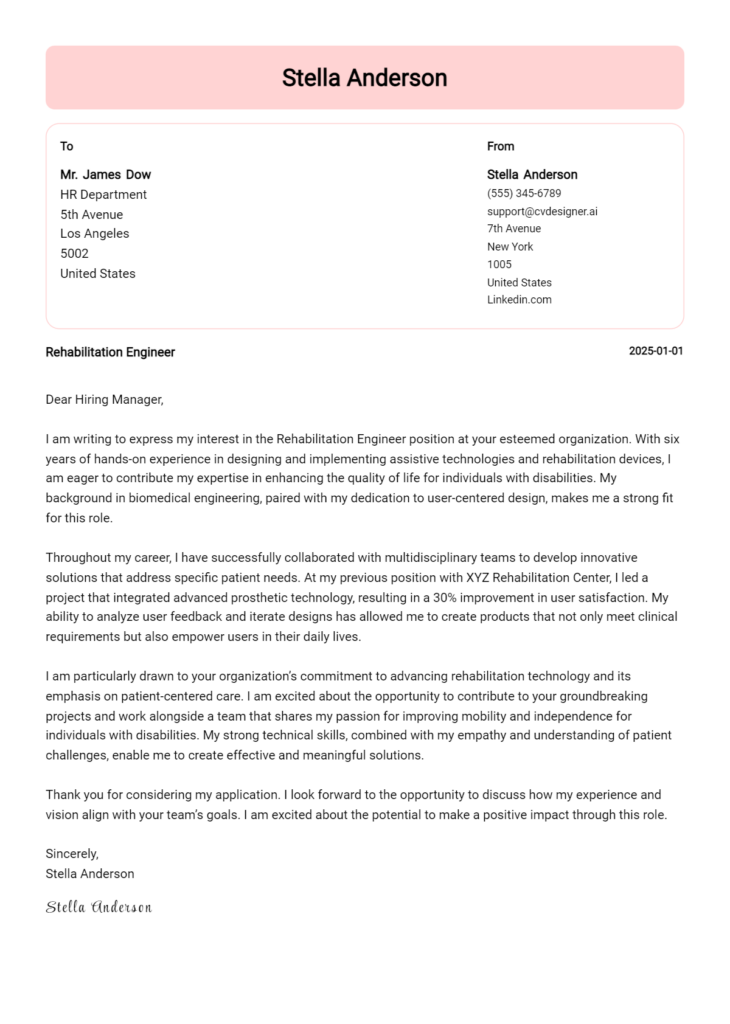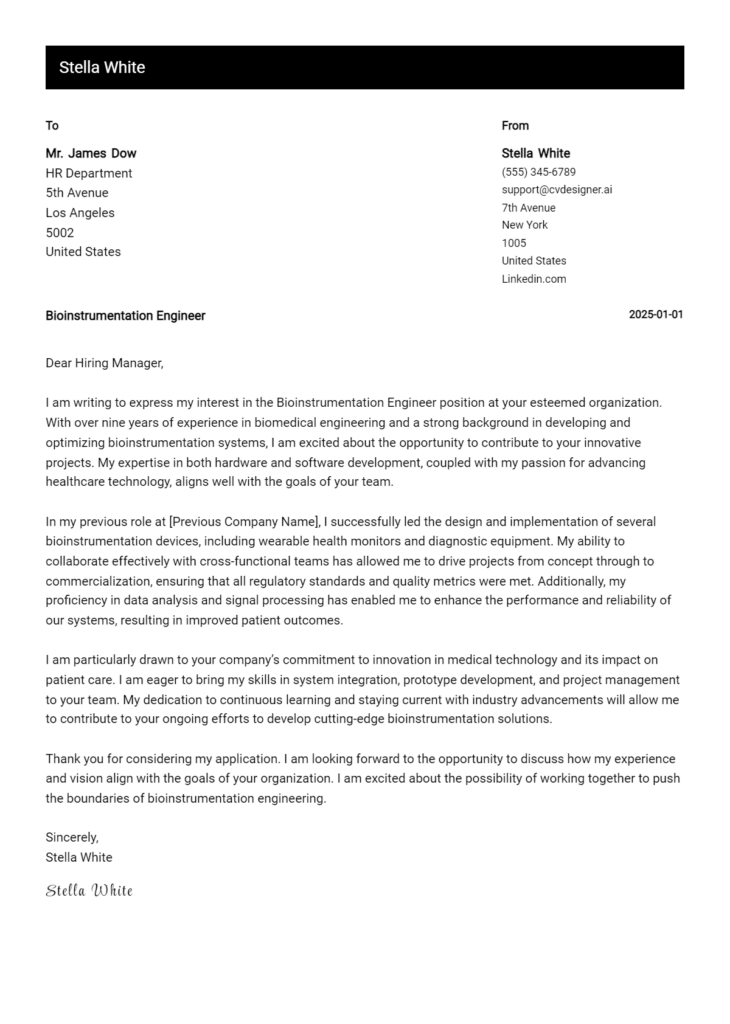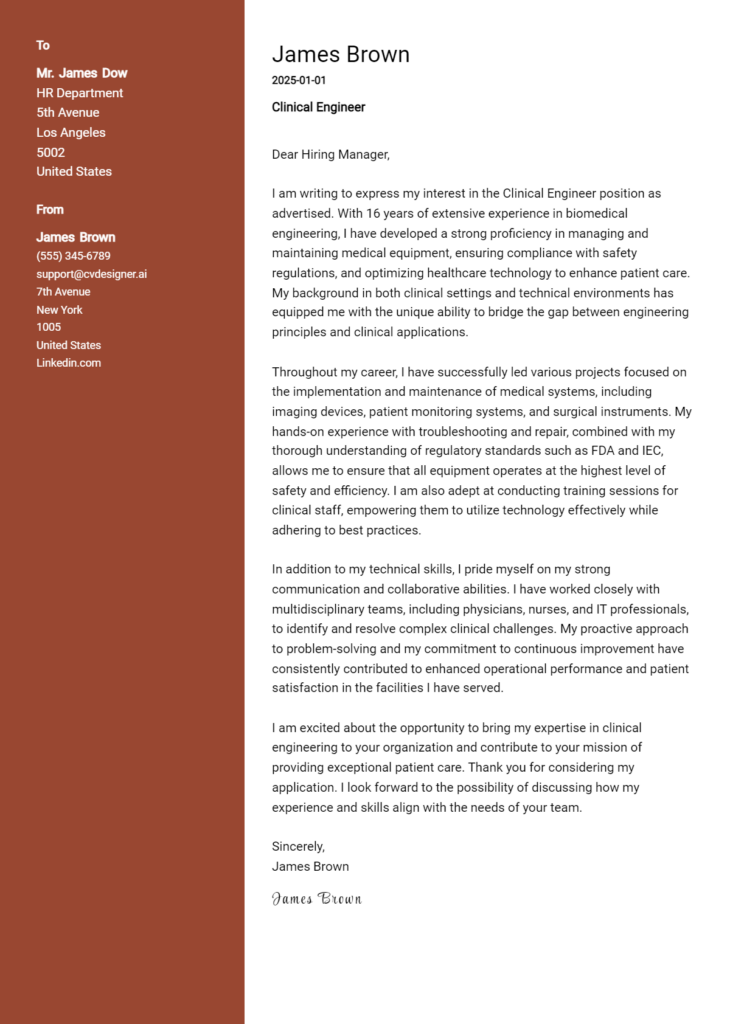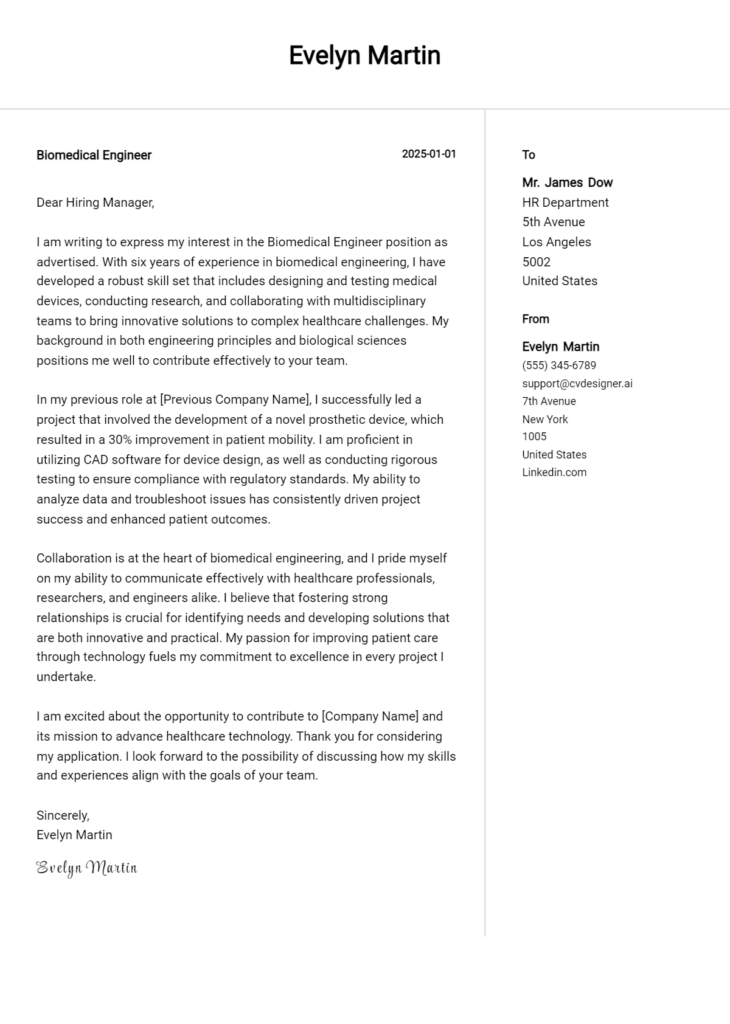Biomaterials Engineer Cover Letter Examples
Explore additional Biomaterials Engineer cover letter samples and guides and see what works for your level of experience or role.
Importance of Cover Letter Formatting for a Biomaterials Engineer
Crafting a compelling cover letter is essential for a Biomaterials Engineer, as it serves as your first opportunity to make a lasting impression on potential employers. The way you format your cover letter not only showcases your qualifications but also reflects your understanding of the intricate details that are fundamental in the field of biomaterials. A well-structured cover letter can effectively communicate your technical skills and innovative thinking, which are critical in contributing to advancements in medical devices, tissue engineering, and sustainable materials.
In this guide, we will explore how to format your cover letter to highlight your expertise in biomaterials engineering, ensuring that you capture the attention of hiring managers. We’ll break down the essential components of a professional cover letter, including:
- Cover Letter Header
- Cover Letter Greeting
- Cover Letter Introduction
- Cover Letter Body
- Cover Letter Closing
Each section is vital in portraying your professionalism and technical aptitude. Let's delve into each part to help you create a standout cover letter that aligns with your career aspirations.
Importance of the Cover Letter Header for a Biomaterials Engineer
The cover letter header is a crucial element of any job application, particularly for a specialized role such as a Biomaterials Engineer. It serves as the first impression to potential employers and sets the tone for the rest of the letter. A clear and professional header includes essential information such as your contact details, the date, and the recipient's information. This ensures that the hiring manager can easily identify who you are and how to reach you, while also establishing a formal context for your application. A well-structured header demonstrates your attention to detail and professionalism, qualities that are highly valued in engineering fields.
Strong Example:
John Doe 123 Innovation Drive San Francisco, CA 94103 johndoe@email.com (555) 123-4567 October 1, 2023 Dr. Jane Smith Hiring Manager BioMaterials Innovations 456 Research Lane San Francisco, CA 94103
Weak Example:
John D. jdoe@email.com Hi, Dr. Smith,
Importance of the Cover Letter Greeting for a Biomaterials Engineer
The greeting of a cover letter is a crucial element that sets the tone for the entire document. It serves as the first impression you make on the hiring manager and can significantly impact their perception of your professionalism and fit for the role. A personalized greeting demonstrates that you have taken the time to research the company and its personnel, which reflects your genuine interest in the position. Avoiding generic salutations, such as "To Whom It May Concern," can make your application stand out. When possible, it is always best to address the hiring manager by name, as this personal touch can foster a connection before they even read the content of your letter. If you are unable to find the recipient's name, consider using a title or department rather than resorting to a vague greeting.
Strong Greeting Example
Dear Dr. Smith,
Weak Greeting Example
To Whom It May Concern,
Importance of a Well-Crafted Cover Letter Introduction for a Biomaterials Engineer
A compelling cover letter introduction is crucial for a Biomaterials Engineer, as it sets the tone for the entire application and can significantly influence a hiring manager's perception of the candidate. This opening paragraph should not only grab attention but also demonstrate genuine interest in the position and the organization. Additionally, it should briefly highlight relevant skills or achievements that align with the job requirements. A strong introduction not only showcases the candidate's qualifications but also conveys enthusiasm and a proactive approach, making it more likely for the hiring manager to read further. Below are examples of both a strong and weak cover letter introduction for a Biomaterials Engineer role.
Strong Example
Dear Hiring Manager, I am excited to apply for the Biomaterials Engineer position at [Company Name], as I am passionate about advancing healthcare solutions through innovative biomaterials. With a Master’s degree in Biomedical Engineering and over five years of hands-on experience in developing biocompatible materials for medical devices, I have successfully led projects that reduced material costs by 30% while improving performance. I am eager to bring my expertise in material selection and testing to your esteemed team, contributing to [Company Name]'s mission of transforming patient care.
Weak Example
To Whom It May Concern, I would like to apply for the job. I studied engineering and have worked in some labs. I think I could do well in this position. I have some skills that might help.
Purpose of the Cover Letter Body for a Biomaterials Engineer
The cover letter body serves as a critical platform for Biomaterials Engineers to effectively communicate their unique skills, relevant experiences, and the value they can bring to a potential employer. This section allows candidates to highlight specific projects or accomplishments that demonstrate their expertise in developing and testing materials used for medical applications, tissue engineering, or drug delivery systems. By providing concrete examples of past work, such as successful collaborations on innovative biomaterial designs or contributions to published research, candidates can illustrate their impact in the field and align their qualifications with the needs of the company.
Strong Example
I am excited to apply for the Biomaterials Engineer position at ABC Corp, where I believe my background in developing biodegradable polymers and extensive project experience will add significant value. During my time at XYZ University, I led a research team that successfully developed a novel scaffold for tissue engineering, which improved cell viability by 30% over existing materials. This project not only honed my skills in material characterization and mechanical testing but also resulted in a publication in a leading biomaterials journal. I am eager to bring my expertise in innovative biomaterial solutions to ABC Corp and contribute to your mission of advancing healthcare technologies.
Weak Example
I am applying for the Biomaterials Engineer position at your company. I have some experience with materials and think I can do the job well. In my last job, I worked on a project, but I don’t remember the details. I am interested in biomaterials and hope to learn more. I believe I can be a good addition to your team.
Importance of the Cover Letter Closing for a Biomaterials Engineer
The closing paragraph of a cover letter is crucial for summarizing your qualifications, reiterating your enthusiasm for the role, and guiding the hiring manager towards the next steps. A strong closing leaves a lasting impression, encouraging the reader to review your resume and consider you for an interview. Conversely, a weak closing can diminish the impact of the rest of your letter, making it less likely that you will stand out among other candidates.
Strong Example
Thank you for considering my application for the Biomaterials Engineer position at [Company Name]. With my extensive background in polymer science and a passion for developing innovative materials for medical applications, I am excited about the opportunity to contribute to your team. I look forward to the possibility of discussing how my expertise can benefit [Company Name]. Please feel free to contact me to schedule an interview. I have attached my resume for your review, and I hope to speak with you soon.
Weak Example
I hope you look at my resume. I think I’m a good fit for the job. Let me know if you want to talk.
Crafting a compelling cover letter is essential for any Biomaterials Engineer looking to make a strong impression on potential employers. This document not only introduces you but also serves as a platform to showcase your technical skills, problem-solving abilities, and understanding of the software development life cycle (SDLC). Furthermore, it’s an opportunity to highlight your teamwork experience and passion for continuous learning, which are crucial in this innovative field. The following tips will guide you in creating an effective cover letter that captures your qualifications and enthusiasm.
Tips for Writing an Effective Cover Letter for a Biomaterials Engineer
Highlight Your Technical Expertise
Begin your cover letter by emphasizing your specific technical skills related to biomaterials. Mention your experience with material selection, characterization, or biocompatibility testing. Be sure to provide examples that demonstrate your proficiency and knowledge of industry standards. This not only showcases your qualifications but also illustrates your readiness to tackle the challenges of the role.Demonstrate Problem-Solving Abilities
Biomaterials engineering often requires innovative solutions to complex problems. Include a brief narrative or example where you successfully addressed a technical challenge. Describe the problem, your approach, and the outcome. This will help potential employers recognize your analytical thinking and your ability to apply theoretical knowledge in practical situations.Showcase Knowledge of SDLC
If applicable, discuss your familiarity with the software development life cycle, particularly in the context of biomaterials research and development. Explain how you have utilized SDLC principles in past projects, such as project management, quality control, and iterative design processes. This knowledge can set you apart as a candidate who understands the importance of a structured approach to engineering projects.Emphasize Teamwork and Collaboration
Engineering projects are often collaborative efforts. Highlight your experience working in cross-functional teams, showcasing your communication skills and ability to work effectively with diverse groups. Mention specific projects where teamwork led to successful outcomes, as this will illustrate your ability to contribute to a positive and productive work environment.Express a Passion for Continuous Learning
The field of biomaterials is constantly evolving, and a commitment to continuous learning is essential. Share your experiences with professional development, such as attending workshops, pursuing certifications, or engaging with the latest research in biomaterials science. This illustrates your proactive approach to staying current in the field and your eagerness to grow as a professional.
By following these tips and utilizing tools like cover letter templates and a cover letter builder, you can create a powerful cover letter that effectively conveys your qualifications and enthusiasm for the role of Biomaterials Engineer.
Common Mistakes to Avoid in a Biomaterials Engineer Cover Letter
Crafting an effective cover letter is essential for standing out as a Biomaterials Engineer, as it showcases your qualifications and passion for the field. To maximize your chances of success, it's crucial to avoid common pitfalls that can undermine your application. Here are some mistakes to watch out for:
- Generic Content: Failing to tailor your cover letter to the specific job can make it seem impersonal. Always customize your letter to reflect the job description and company values.
- Overly Technical Language: While technical expertise is important, using excessive jargon can alienate readers. Balance technical terms with clear explanations to ensure your message is accessible.
- Neglecting Formatting: Poor formatting can detract from your professionalism. Follow a clear cover letter format to ensure your letter is organized and easy to read.
- Lack of Specific Examples: Vague statements about your skills can weaken your case. Use specific examples to demonstrate your accomplishments and their relevance to the position.
- Ignoring the Employer's Needs: Focusing solely on what you want can come across as self-centered. Instead, emphasize how your skills can benefit the employer and contribute to their goals.
- Typos and Grammatical Errors: Mistakes in spelling or grammar can create a negative impression. Proofread your letter multiple times and consider having someone else review it.
- Being Too Lengthy: A lengthy letter can lose the reader's attention. Aim for a concise cover letter that highlights your main qualifications and enthusiasm for the role.
By avoiding these common mistakes and following effective cover letter examples, you can create a compelling cover letter that captures the attention of hiring managers in the biomaterials engineering field.
Cover Letter FAQs for Biomaterials Engineer
What should I include in my cover letter as a Biomaterials Engineer?
In your cover letter, highlight your technical skills and experience in biomaterials, such as polymer science, biocompatibility testing, and material characterization. Mention specific projects where you've successfully developed or tested biomaterials, emphasizing your role and contributions. Additionally, discuss your understanding of regulatory guidelines, such as those from the FDA or ISO, that pertain to biomaterials. Personalize your cover letter for each job application by aligning your experiences with the company’s mission and the specific requirements of the position. Finally, express your passion for advancing biomaterials technology and improving patient outcomes, which demonstrates your motivation for the role.
How do I demonstrate my technical skills in the cover letter?
To effectively demonstrate your technical skills in your cover letter, use specific examples and quantitative data to illustrate your accomplishments. For instance, mention any successful projects where you developed a new biomaterial that improved performance metrics, such as increased tensile strength or enhanced biocompatibility. Describe the methodologies you employed, whether it was through laboratory experiments or computational modeling. Additionally, if you have experience with software tools relevant to biomaterials engineering, such as MATLAB or COMSOL, include them. This not only shows your technical proficiency but also your ability to apply these skills in real-world scenarios, making your application stand out.
How should I address gaps in my experience or education in my cover letter?
If you have gaps in your experience or education, address them proactively in your cover letter. Focus on how you have utilized that time for personal or professional development, such as pursuing additional coursework, certifications, or relevant volunteer work. Highlight transferable skills gained from other experiences, such as teamwork, problem-solving, or project management. Emphasize your eagerness to learn and adapt, which is crucial in the rapidly evolving field of biomaterials. Lastly, reinforce your commitment to the role by discussing how your diverse background can bring a unique perspective to the team and contribute to innovative solutions.
How can I make my cover letter stand out among other applicants?
To make your cover letter stand out, begin with a compelling opening that captures the reader's attention—perhaps by mentioning a notable achievement or a specific aspect of biomaterials that excites you. Tailor your content to the company and position by conducting research to understand their projects, values, and challenges. Use a clear, professional tone while showcasing your unique personality and passion for biomaterials. Incorporate keywords from the job description to align your qualifications with the employer's needs. Finally, conclude with a strong closing statement that reiterates your enthusiasm for the position and invites further discussion, making it clear that you are eager to contribute to the team.
Build your Cover Letter in minutes
Use an AI-powered cover letter builder and have your letter done in 5 minutes. Just select your template and our software will guide you through the process.

